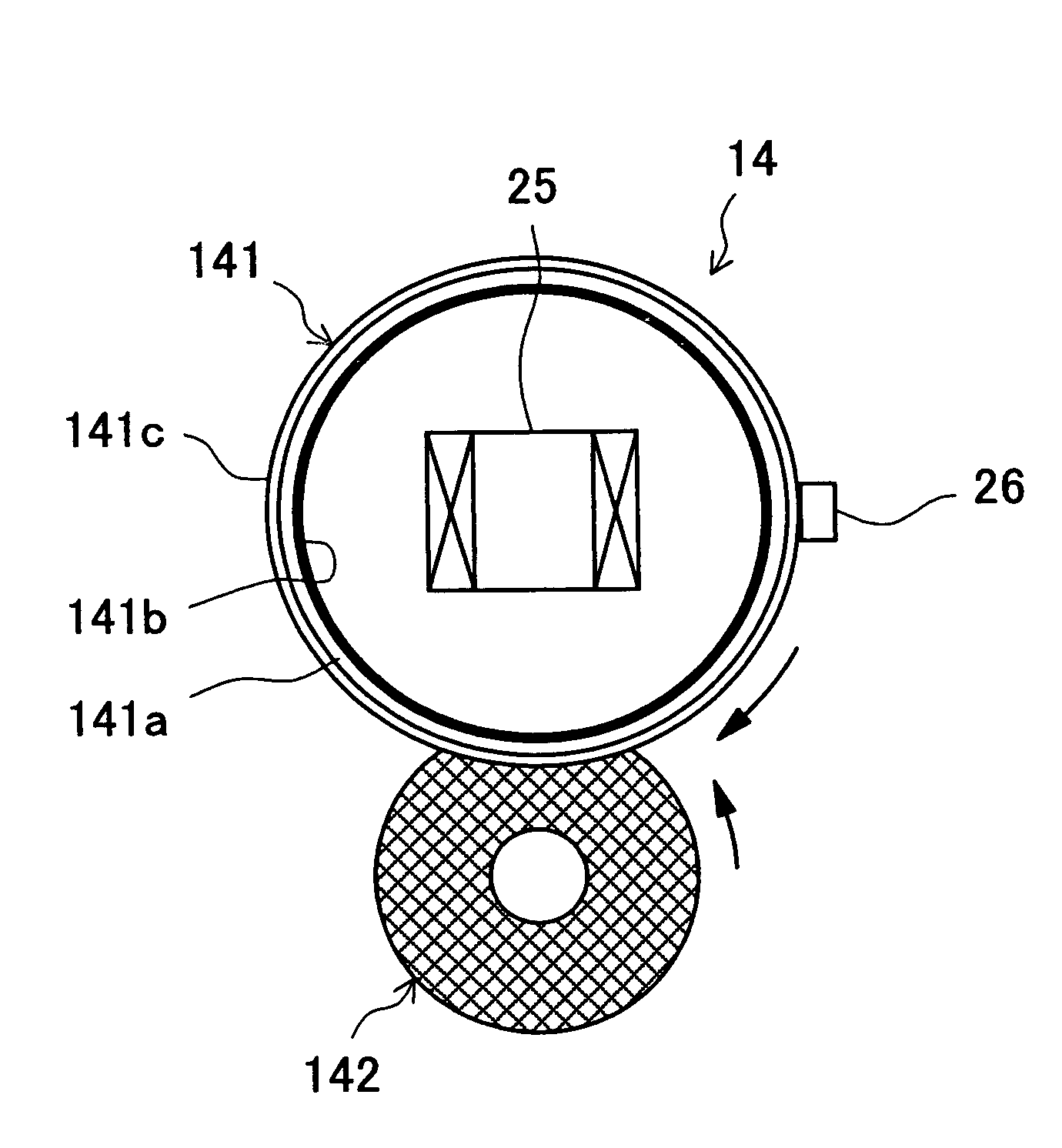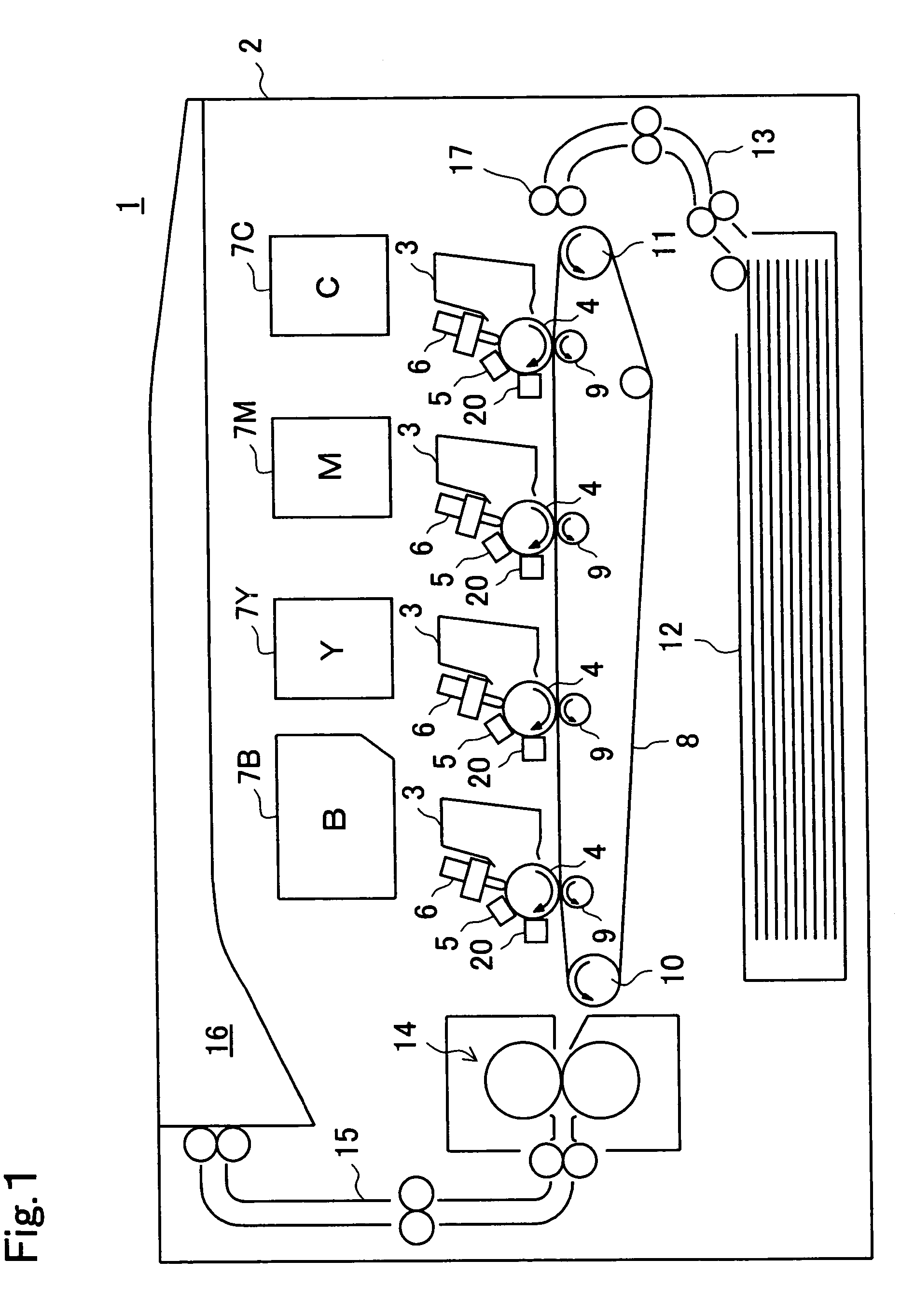Fixing apparatus
a technology of fixing apparatus and fixing plate, which is applied in the direction of electric/magnetic/electromagnetic heating, instruments, electrographic processes, etc., can solve the problems of inefficient heat conduction to the roller surface, large heat loss, and the need for a long time to heat the roller surface to a sufficiently high temperature, so as to prevent leakage of magnetic flux, high heating efficiency, and stable heating. easy
- Summary
- Abstract
- Description
- Claims
- Application Information
AI Technical Summary
Benefits of technology
Problems solved by technology
Method used
Image
Examples
first embodiment
[0079]the invention will be described with reference to the drawings.
[0080]FIG. 1 shows an outline of the construction of an image forming apparatus incorporating a fixing apparatus according to the invention. A printer 1 is presented as an example of an image forming apparatus. The printer 1 incorporates, inside a body 2, developing apparatuses 3, one for each of cyan, magenta, yellow, and black colors. The developing apparatuses 3 are each provided with a photoconductive drum 4 having a photoconductive layer formed of amorphous silicon or the like. The photoconductive drum 4 rotates in the direction indicated by an arrow in the figure.
[0081]The surface of the photoconductive drum 4 is uniformly charged by a charger 5. When the charged surface of the photoconductive drum 4 is irradiated with LED light emitted from an LED print head unit 6 according to original image data fed from an external computer or the like, an electrostatic latent image is formed on the surface of the photoco...
second embodiment
[0109]In the fixing apparatus 14 of the second embodiment, the exciting coil 25 is disposed outside the fixing roller 141 so as to face the surface of the fixing roller 141. In this case, by disposing the exciting coil 25 near the nip between the fixing and pressure rollers 141 and 142, it is possible to efficiently heat only the portion of the heating layer 141b that is nearing the nip at every moment.
[0110]By using as the thermistor 26 a non-contact-type thermistor that offers satisfactorily fast response, it is possible to eliminate friction between the stick-free layer 141c formed at the surface of the fixing roller 141 and the thermistor 26. This helps prolong the life of the fixing roller 141, in particular its stick-free layer 141c.
[0111]In a case where the exciting coil 25 is disposed outside the fixing roller 141 in this way, the heating layer 141b is formed on the outer surface of the support member 141a, and the stick-free layer 141c is formed further outside, i.e., on t...
third embodiment
[0116]With the construction of the third embodiment, the exciting coil 25 makes also the heating layer 142b of the pressure roller 142 generate heat. Thus, paper and toner can be heated also from the side of the pressure roller 142.
[0117]Moreover, the thermistor 26 is disposed inside the fixing roller 141, and thus does not restrict the placement of the exciting coil 25. The thermistor 26 itself can be disposed in a position corresponding to the nip between the fixing and pressure rollers 141 and 142. This makes it possible to accurately measure the temperature at the nip, and thus to accurately control the temperature of the fixing roller 141 and / or pressure roller 142.
[0118]Next, the construction of the fixing apparatus of a fourth embodiment of the invention will be described with reference to FIG. 7. FIG. 7 is a sectional view showing an outline of the construction of the fixing apparatus of the fourth embodiment.
[0119]In the fixing apparatus 14 of the fourth embodiment, as in t...
PUM
 Login to View More
Login to View More Abstract
Description
Claims
Application Information
 Login to View More
Login to View More - R&D
- Intellectual Property
- Life Sciences
- Materials
- Tech Scout
- Unparalleled Data Quality
- Higher Quality Content
- 60% Fewer Hallucinations
Browse by: Latest US Patents, China's latest patents, Technical Efficacy Thesaurus, Application Domain, Technology Topic, Popular Technical Reports.
© 2025 PatSnap. All rights reserved.Legal|Privacy policy|Modern Slavery Act Transparency Statement|Sitemap|About US| Contact US: help@patsnap.com



